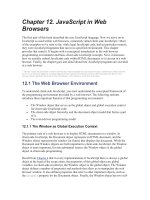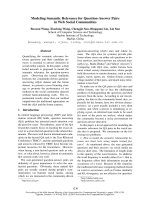JavaScript in Web Browsers
Bạn đang xem bản rút gọn của tài liệu. Xem và tải ngay bản đầy đủ của tài liệu tại đây (201.17 KB, 18 trang )
Chapter 12. JavaScript in Web
to
lient-side JavaScript.
[1]
Browsers
The first part of this book described the core JavaScript language. Now we move on
JavaScript as used within web browsers, commonly called c Most
of the examples we've seen so far, while legal JavaScript code, had no particular context;
hat ran in no specified environment. This chapter
provides that context. It begins with a conceptual introduction to the web browser
programming environment and basic client-side JavaScript concepts. Next, it discusses
a web
ient-side JavaScript" is left over from the days when JavaScript was used in only two places: web browsers (clients) and web
aScript is adopted as a scripting language in more and more environments, the term client-side makes less and less sense
because it doesn't specify the client side of what. Nevertheless, we'll continue to use the term in this book.
12.1 The Web Browser Environment
r
document object model that forms a part
o
x T
12.1.1 The Window as Global Execution Context
The primary task of a web browser is to display HTML documents in a window. In
client-side JavaScript, the Document object represents an HTML document, and the
e
they were JavaScript fragments t
how we actually embed JavaScript code within HTML documents so it can run in
browser. Finally, the chapter goes into detail about how JavaScript programs are executed
in a web browser.
[1]
The term "cl
servers. As Jav
To understand client-side JavaScript, you must understand the conceptual framework of
the programming environment provided by a web browser. The following sections
introduce three important features of that programming environment:
x The Window object that serves as the global object and global execution context
for client-side JavaSc ipt code
x The client-side object hierarchy and the
f it
he event-driven programming model
Window object represents the window (or frame) that displays the document. While th
Document and Window objects are both important to client-side JavaScript, the Window
object is more important, for one substantial reason: the Window object is the global
object in client-side programming.
Recall from
Chapter 4 that in every implementation of JavaScript there is always a global
object at the head of the scope chain; the properties of this global object are global
variables. In client-side JavaScript, the Window object is the global object. The Window
object defines a number of properties and methods that allow us to manipulate the web
browser window. It also defines properties that refer to other important objects, such as
the
document property for the Document object. Finally, the Window object has two self-
referential properties, window and self. You can use either of these global variables to
refer directly to the Window object.
Since the Window object is the global object in client-side JavaScript, all global variables
are defined as properties of the window. For example, the following two lines of code
perform essentially the same function:
var answer = 42; // Declare and initialize a global variable
hat use multiple windows. Each window or frame
involved in an application has a unique Window object and defines a unique execution
context for client-side JavaScript code. In other words, a global variable declared by
JavaScript code in one frame is not a global variable within a second frame. However, the
second frame
can access a global variable of the first frame; we'll see how when we
consider these issues in more detail in
Chapter 13
window.answer = 42; // Create a new property of the Window object
The Window object represents a web browser window or a frame within a window. To
client-side JavaScript, top-level windows and frames are essentially equivalent. It is
common to write JavaScript applications that use multiple frames, and it is possible, if
less common, to write applications t
.
object
contains a document property that refers to the Document object associated with the
window and a location property that refers to the Location object associated with the
window. A Window object also contains a frames[] array that refers to the Window
objects that represent the frames of the original window. Thus, document represents the
Document object of the current window, and frames[1].document refers to the
Document object of the second child frame of the current window.
An object referenced through the current window or through some other Window object
may itself refer to other objects. For example, every Document object has a forms[]
array containing Form objects that represent any HTML forms appearing in the
document. To refer to one of these forms, you might write:
To continue with the same example, each Form object has an elements[] array
s (input fields, buttons,
ode that refers to an
object at the end of a whole chain of objects, ending up with expressions as complex as
this one:
12.1.2 The Client-Side Object Hierarchy and the Document Object
Model
We've seen that the Window object is the key object in client-side JavaScript. All other
client-side objects are connected to this object. For example, every Window
window.document.forms[0]
containing objects that represent the various HTML form element
etc.) that appear within the form. In extreme cases, you can write c
parent.frames[0].document.forms[0].elements[3].options[2].text
We've seen that the Window object is the global object at the head of the scope chain and
that all r objects. This
means that there is a hierarchy of JavaScript
client-side objects in JavaScript are accessible as properties of othe
objects, with the Window object at its root.
Figure 12-1 shows this hierarchy. Study this figure carefully; understanding the hierarchy
and the objects it contains is crucial to successful client-side JavaScript programming.
Most of the remaining chapters of this book are devoted to fleshing out the details of the
objects shown in this figure.
Figure 12-1. The client-side object hierarchy and Level 0 DOM
Note that Figure 12-1 shows just the object properties that refer to other objects. Most of
the objects shown in the diagram have quite a few more properties than those shown.
Many of the objects pictured in Figure 12-1 descend from the Document object. This
subtree of the larger client-side object hierarchy is known as the document object model
(DOM), which is interesting because it has been the focus of a standardization effort.
Figure 12-1 illustrates the Document objects that have become de facto standards because
they are consistently implemented by all major browsers. Collectively, they are known as
the Level 0 DOM, because they form a base level of document functionality that
JavaScript programmers can rely on in all browsers. These basic Document objects are
the subject of Chapter 14 and Chapter 15. A more advanced document object model that
is the subject of Chapter 17has been standardized by the W3C and Chapter 18.
g Model
data, did some computation on that data, and then wrote out the results. Later, with time-
sharing and text-based terminals, limited kinds of interactivity became possible -- the
could ask the user for input, and the user could type in data. The computer could
ata and display the results on screen.
s and pointing devices like mice, the situation is
driven; they respond to asynchronous user input
t depends on the position of the
mouse point s just such a graphical environment. An HTML document
n embedded graphical user interface (GUI), so client-side JavaScript uses the
en programming model.
It is perfectly possible to write a static JavaScript program that does not accept user input
and does exactly the same thing every time. Sometimes this sort of program is useful.
More often, however, we want to write dynamic programs that interact with the user. To
do this, we must be able to respond to user input.
In client-side JavaScript, the web browser notifies programs of user input by generating
events. There are various types of events, such as keystroke events, mouse motion events,
and so on. When an event occurs, the web browser attempts to invoke an appropriate
eractive client-
side JavaScript programs, we must define appropriate event handlers and register them
at appropriate times.
ed to the event-driven programming model, it can take a
little getting used to. In the old model, you wrote a single, monolithic block of code that
followed some well-defined flow of control and ran to completion from beginning to end.
Event-driven programming stands this model on its head. In event-driven programming,
you write a number of independent (but mutually interacting) event handlers. You do not
e time, your program is not running at all
tem to invoke one of its event handlers.
ows
efine both static blocks of code that run synchronously from start to finish
and event handlers that are invoked asynchronously by the system. We'll also discuss
events and event handling in much greater detail in
Chapter 19
12.1.3 The Event-Driven Programmin
In the old days, computer programs often ran in batch mode -- they read in a batch of
program
then process the d
Nowadays, with graphical display
different. Programs are generally event
in the form of mouse-clicks and keystrokes in a way tha
er. A web browser i
contains a
event-driv
event handler function to respond to the event. Thus, to write dynamic, int
with the system, so that the browser can invoke them
If you are not already accustom
invoke these handlers directly, but allow the system to invoke them at the appropriate
times. Since they are triggered by the user's input, the handlers will be invoked at
unpredictable, asynchronous times. Much of th
but merely sitting waiting for the sys
The next section explains how JavaScript code is embedded within HTML files. It sh
how we can d
.
12.2 Embedding JavaScript in HTML
Client-side JavaScript code is embedded within HTML documents in a number of ways:
x Between a pair of <script> and </script> tags
x From an external file specified by the src attribute of a <script> tag
x In an event handler, specified as the value of an HTML attribute such as onclick
or
e special javascript: protocol
The following sections document each of these JavaScript embedding techniques in more
detail. Together, they explain all the ways to include JavaScript in web pages -- that is,
they explain the allowed structure of JavaScript programs on the client side.
JavaScript scripts are part of an HTML file and are coded within <script>
hese
ss.
<script> tags may appear in either the <head> or <body> of an HTML document.
A single HTML document may contain any number of nonoverlapping pairs of <script>
and </script> tags. These multiple, separate scripts are executed in the order in which
efer to x, even though it's in a different script
page, not the script block:
<script>document.write(x);</script>
onmouseover
x As the body of a URL that uses th
12.2.1 The <script> Tag
Client-side
and </script> tags. You may place any number of JavaScript statements between t
tags; they are executed in order of appearance, as part of the document loading proce
they appear within the document. While separate scripts within a single file are executed
at different times during the loading and parsing of the HTML file, they constitute part of
the same JavaScript program: functions and variables defined in one script are available
to all scripts that follow in the same file. For example, you can have the following script
somewhere in an HTML page:
<script>var x = 1;</script>
Later on in the same HTML page, you can r
lock. The context that matters is the HTMLb
The
document.write( ) method is an important and commonly used one. When used as
shown here, it inserts its output into the document at the location of the script. When the
script finishes executing, the HTML parser resumes parsing the document and starts by
parsing any text produced with document.write( ).
Example 12-1 shows a sample HTML file that includes a simple JavaScript program.
Note the difference between this example and many of the code fragments shown earlier
in this book: this one is integrated with an HTML file and has a clear context in which it
runs. Note also the use of a
language attribute in the <script> tag. This is explained in
the next section.
Example 12-1. A simple JavaScript program in an HTML file
<html>
<head>
<title>Today's Date</title>
<script language="JavaScript">
are:<br>
nguage="JavaScript">
all the function we defined above
12.2.1.1 The language and type attributes
only used client-side scripting language, it is
ser what language a script is written in, the
script> tag has an optional language attribute. Browsers that understand the specified
scripting language run the script; browsers that do not know the language ignore it.
If you are writing JavaScript code, use the language attribute as follows:
<script language="JavaScript">
// JavaScript code goes here
</script>
// Define a function for later use
function print_todays_date( ) {
var d = new Date( ); // Get today's date and
time
document.write(d.toLocaleString( )); // Insert it into the
document
}
</script>
</head>
<body>
The date and time
<script la
// Now c
print_todays_date( );
</script>
</body>
</html>
Although JavaScript is by far the most comm
not the only one. In order to tell a web brow
<
If, for example, you are writing a script in Microsoft's Visual Basic Scripting Edition
language,
[2]
you would use the attribute like this:
[2]
Also known as VBScript. The only browser that supports VBScript is Internet Explorer, so scripts written in this language are not portable.
VBScript interfaces with HTML objects in the same way that JavaScript does, but the core language itself has a different syntax than
JavaScript. VBScript is not documented in this book.
<script language="VBScr
' VBScript code goes here (' is a comment character like // in
ipt">
JavaScript)
</script>
JavaScript is the default scripting language for the Web, and if you omit the language
attribute, both Netscape and Internet Explorer will assume that your scripts are written in
The HTML 4 specification standardizes the <script> tag, but it deprecates the language
languages. Instead, the
specification prefers the use of a type attribute that specifies the scripting language as a
MIME type. Thus, in theory, the preferred way to embed a JavaScript script is with a tag
that looks like this:
<script type="text/javascript">
In practice, the language attribute is still better supported than this new type attribute.
The HTML 4 specification also defines a standard (and useful) way to specify the default
scripting language for an entire HTML file. If you plan to use JavaScript as the only
scripting language in a file, simply include the following line in the <head> of the
document:
<meta http-equiv="Content-Script-Type" content="text/javascript">
If y d
type at
Since JavaScript is the default scripting language, those of us who program with it never
really need to use the language attribute to specify the language in which a script is
written. However, there is an important secondary purpose for this attribute: it can also be
used to specify what version of JavaScript is required to interpret a script. When you
specify the language="JavaScript" attribute for a script, any JavaScript-enabled
browser will run the script. Suppose, however, that you have written a script that uses the
exception-handling features of JavaScript 1.5. To avoid syntax errors in browsers that do
not support this version of the language, you could embed your script with this tag:
<script language="JavaScript1.5">
changes only when "JavaScript1.2" was explicitly specified in the language attribute.
JavaScript.
attribute because there is no standard set of names for scripting
ou o this, you can safely use JavaScript scripts without specifying the
language or
tributes.
If you do this, only browsers that support JavaScript 1.5 (and its exception-handling
features) will run the script; any others will ignore it.
The use of the string "JavaScript1.2" in the language attribute deserves special mention.
When Netscape 4 was being prepared for release, it appeared that the emerging ECMA-
262 standard would require some incompatible changes to certain features of the
language. To prevent these incompatible changes from breaking existing scripts, the
designers of JavaScript at Netscape took the sensible precaution of implementing the









